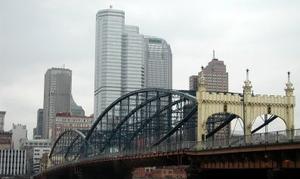Pennsylvania's bridge structural deficiency rate is nearly double the national average
There are 4,284 bridges in the 5-county Pittsburgh area, and 1,246 of them, or 29 percent, are rated structurally deficient; this means that at least one bridge element — its superstructure, substructure, or deck — was found by inspectors to be in poor or worse-than-poor condition; Pennsylvania’s 22 percent bridge structural deficiency rate is nearly double the national average

One of Pittsburgh's 4,000-plus bridges // Source: about.com
The bridge on Babcock Boulevard over Girtys Run in Shaler is not the stuff of a picture postcard. Eighty-three feet long, the steel girder span is eighty years old, and showing it. Its most recent inspection found “serious” deterioration of structural elements, and on a 100-point sufficiency scale, with 100 being the top score, it rated 4.
Replacement of the bridge has been delayed until 2013 or 2014 because of a state transportation funding crisis. That happens to be one of the rosier scenarios in the Pittsburg region’s bridge network.
The Pittsburgh Post-Gazette’s Jon Schmitz writes that for at least seventy-six other bridges with serious deficiencies in the 5-county Pittsburgh area, no rehabilitation or replacement projects are planned because there is no money for them.
They range from big, like the 59-year-old Elizabeth Bridge, which carries 17,000 vehicles per day over the Monongahela River, to small, like the 10-foot-long span over a stream on Stiffin Hill Road in Beaver Falls. It was built in 1930, has a sufficiency rating of just 2, and no funding is identified to fix or replace it.
Governor Ed Rendell visited Pittsburgh and other sites in Western Pennsylvania Friday morning as part of a weeklong, statewide bus tour to call attention to the funding shortfall and urge the Legislature to address it at a special session later this month.
A Pittsburgh Post-Gazette analysis of state bridge data found that in Allegheny, Beaver, Butler, Washington, and Westmoreland counties, 1,246 of the 4,284 bridges, or 29 percent, are rated structurally deficient.
This means that at least one bridge element — its superstructure, substructure, or deck — was found by inspectors to be in poor or worse-than-poor condition.
Despite a recent effort to focus its limited transportation funding on bridge rehabilitation, Pennsylvania still has more than 5,600 structurally deficient bridges on state roads, the highest total in the nation. The state’s 22 percent deficiency rate is nearly double the national average.
Another 2,159 bridges on locally owned roads in the state are considered deficient. One study has estimated the backlog of needed bridge work at $11 billion.
Schmitz writes that the Pennsylvania Department of Transportation estimates that repairs of 449 bridges statewide will be delayed by the funding shortfall caused by the federal government’s refusal to allow tolls on Interstate 80. The tolls were a key piece of Act 44, passed by the Legislature in 2007 to provide adequate funding in hopes of stemming or reversing decades of decline in the state’s transportation infrastructure.
The failure to toll I-80 stanched the flow of Act 44 money into the state’s highway and bridge programs by about $300 million per year. The Southwestern Pennsylvania Commission, in a recent update of the region’s four-year Transportation Improvement Program, slashed anticipated road and bridge spending by 32 percent.
Because of the statewide focus on bridges and the one-time infusion of federal economic stimulus money last year, PennDOT was “slowly gaining ground” on its backlog of deficient bridges, said Cheryl Moon-Sirianni, assistant district executive for Allegheny, Beaver and Lawrence counties.
A 32 percent cut will have a “huge impact” on bridge work, she said. “If we don’t have that level of investment, there’s no doubt the structurally deficient percentage is going to go up.”
In all, PennDOT has identified seventy-six bridges in the five counties that cannot be rehabilitated or replaced because of the reduction in Act forty-four funding. The average age of the bridges is seventy-two years, and combined they carry more than 340,000 vehicles on a typical day.
Moon-Sirianni said PennDOT is doing what it can to make minor repairs. “We’re trying to Band-Aid them as much as possible” to avoid imposing weight limits or closing them altogether, she said.
PennDOT is required by federal law to inspect every bridge that is twenty feet or longer at least every two years. Some older and more deteriorated structures are checked more frequently — every year or every six months, said district bridge engineer Lou Ruzzi.
The state ramped up its inspections in 2005 after a bridge over Interstate 70 in Washington County collapsed, injuring five people. The danger of decaying bridges was more tragically illustrated in Minnesota in 2007 when the I-35W bridge in Minneapolis collapsed, killing 13 and injuring 145.
